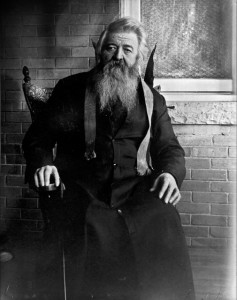
By Katie Hunhoff
South Dakota was the first state to allow voters to enact or block laws through the initiative and referendum process. Since then, we the people have passed laws on corporate farms, Right to Work, term limits, Daylight Savings Time, the minimum wage, nuclear waste and even dove hunting.
Our process of voter-enacted laws and referendums is getting a lot of attention in this year’s legislative session in Pierre. Depending on your point of view, you can credit or blame a Catholic priest from Aberdeen for all the fuss. Father Robert Haire is known as the father of the initiative and referendum. Born in Michigan in 1845, he grew up in an Irish Presbyterian family. He taught school as a young man and boarded with an Irish Catholic family who inspired him to convert in 1865. He eventually entered the seminary, became a priest and then headed west to Brown County, Dakota Territory with several of his parishioners, arriving on June 26, 1880. The next day he said his first Mass in a sod shanty, and began to plan for Brown County’s first Catholic Church.
He founded a school, Presentation Academy, in 1888. And he became the state leader of the Knights of Labor, as well as the group’s newspaper editor. From there his political involvement blossomed. He was active in the Dakota Farmers Alliance, a group created to protect farmers’ interests from politicians, corporations and railroads. Haire directed the Alliance’s political wing, which later become the Populist Party. He advocated the idea of the initiative and referendum for years before it became a part of the Populists’ platform.
Haire distrusted politicians and felt strongly that citizens should also have the ability and right to propose laws without having to go through elected representatives. In an 1891 issue of the Dakota Ruralist he wrote: “These men make the laws to suit themselves — are a law to themselves. The people seldom get any law passed they want.”
South Dakota became the first state to adopt the initiative and referendum process in 1898, passing easily on the same ballot that re-elected South Dakota’s Populist Governor Andrew E. Lee. Twenty-six states now allow some variation of the initiative and referendum.
Father Haire left other notable legacies in Aberdeen, including the creation of Northern State University, originally Northern Normal and Industrial School, in 1901. Today a memorial to Father Haire stands on campus.
As a political and religious leader during tumultuous times in our state’s history, Haire made friends and enemies. He spoke his mind even when he knew it might antagonize Bishop Martin Marty or his own parishioners. He eventually was dismissed by Marty for his radical views. He remained a priest but could not practice. Later, Bishop O’Gorman reinstated him and appointed him chaplain to the Presentation Sisters, a role he served for the remainder of his life. After Haire’s death in 1916, O’Gorman wrote this epitaph: “He had been in earlier years, when the State was still in the pioneer stage, a most zealous missionary. I believe that the last ten peaceful years of his life and his happy death were rewards of the good and fruitful work of the early years.”
Katie Hunhoff is the editor of South Dakota Magazine, a bi-monthly print publication featuring the people and culture of our great state. A feature story on Father Haire by Patrick Gallagher originally appeared in the September/October 2009 issue of South Dakota Magazine. For more information or for contact information, visit www.SouthDakotaMagazine.com
